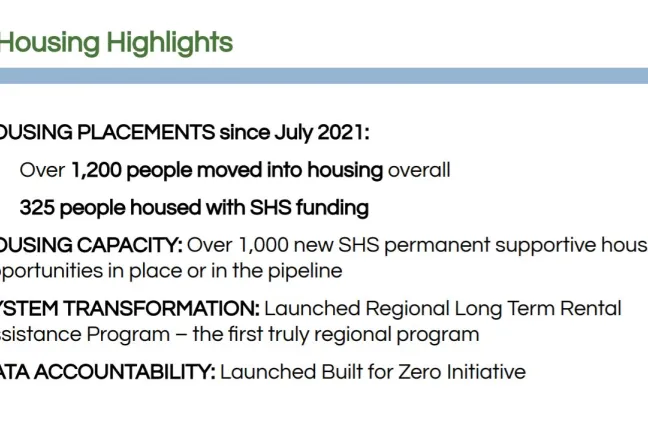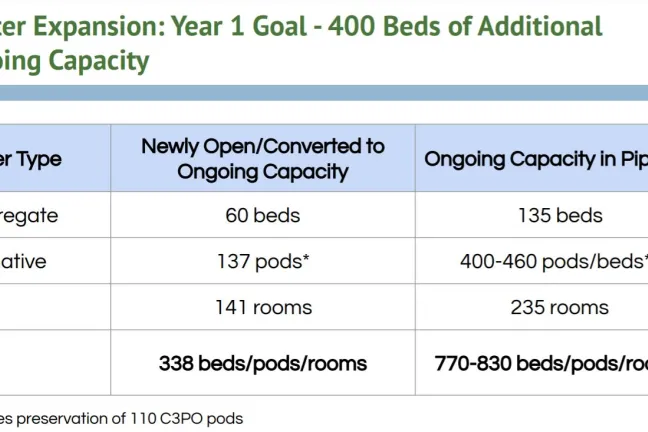With applause and praise for the Joint Office of Homeless Services, the Board of County Commissioners on Thursday, Jan. 28, unanimously approved a 10-year regional contract that sets clear rules for the oversight of Metro’s landmark Supportive Housing Services ballot measure.
The vote followed almost a year of negotiations led in part by the Joint Office of Homeless Services, the County Attorney’s Office and Chair Deborah Kafoury’s Office. Multnomah County was the final party to approve the agreement, joining Metro and Clackamas and Washington counties.
“This was an ambitious undertaking,” said Marc Jolin, director of the Joint Office. “It was critical to come to an agreement that met the needs of all four parties and could stand the test of time.”
“This has been a ton of work,” Chair Kafoury said, noting that even though the County has negotiated many other agreements like this one, “the size and scope, and the importance of this one, really puts it in a league of its own. So a heartfelt thanks from me.”
But even as the final agreement was taking shape, Multnomah County wasn’t waiting to put this year’s $52 million allocation to immediate use. The Joint Office has moved hundreds of people into permanent homes, added new shelter options, and expanded street outreach, community cleanup and behavioral health services.
In Board briefings held Jan. 18 and Jan. 25, days before Thursday’s vote, Joint Office staff and service providers shared stories and statistics that made clear just how much they’d accomplished since July 2021, when funds from the measure first became available.
Highlights from the measure’s first six months included:
- At least 320 people left the streets or shelters for homes of their own thanks to funds from the Metro measure. That figure is about a quarter of the total number of people housed by the Joint Office in that span.
- Funds from the measure meant more than 300 shelter beds, sleeping pods and motel rooms either opened for the first time, or were converted from temporary capacity to ongoing capacity.
- A first-of-its-kind Regional Long-Term Rent Assistance program that provides locally funded rent vouchers to vulnerable people who might otherwise be screened out by the higher-barrier federal Section 8 program.
- New initiatives around trash collection, hygiene stations and employment services led to 34 cleanup projects, with at least 76,000 pounds of trash collected. The effort also provided more than 3,400 showers.
- Navigation teams that work intensively with people in high-impact encampments have been expanded, with two-thirds of 15 new positions hired.
“Following the budget and prioritization plan that each one of you approved — thank you for that — we are putting the Metro measure resources into the community right now,” Jolin told the Board. “And these dollars are making a difference right now.”
Community-based oversight and accountability in the 10-year agreement
The intergovernmental agreement signed Jan. 27 sets a foundation for continuing that progress over the life of the Supportive Housing Services measure.
It allows each of the three counties to set their own policy and budget priorities for addressing chronic homelessness — albeit within the framework established by the measure, which specifically calls out supportive housing in both its terms and title.
In Multnomah County, for example, the Board unanimously approved a priority-setting “local implementation plan” for the Joint Office in December 2020. Then, in June 2021, the Board unanimously approved a Joint Office budget for the Metro funds that was shaped by that plan.
The new regional contract also ensures that Metro, as the agency distributing funds to the counties, will continue to play its role coordinating work among the three counties and — importantly — providing regional oversight and accountability around how the counties achieve their goals.
To achieve that oversight, the contract calls for four separate review panels that will focus on the three counties’ performance, finances and regional coordination.
Two of those panels will be led by government staff from Metro and the counties. An Executive Committee will provide a shared forum to hash through the day-to-day details of implementation, and to tackle any challenges that may come up. A financial review team will keep an eye on revenue forecasts and track spending.
But the other two panels will be guided by the community.
A Regional Oversight Committee in charge of reviewing quarterly outcome reports and approving each county’s local implementation plan is already meeting. Its members include non-voting elected representatives from all three county boards and the City of Portland, Jolin said.
The counties and Metro are also working to recruit community members from a range of backgrounds to serve on the fourth panel, a new tri-county planning committee. That committee will devote itself to developing recommendations around regional alignment. Jolin noted that the measure requires each of the three counties to set aside a portion of their Supportive Housing Services funds for regional work.
“I can’t stress enough how important today’s vote will be for the accountability and oversight of the measure,” Jolin said Thursday.
Commissioner Sharon Meieran asked how community members would be chosen to serve on the tri-county planning committee. Liam Frost, Chair Kafoury’s homelessness and housing policy advisor, said each County board would work together to nominate a slate of members.
“People are interested and are applying, and they want to know how the decisions are being made,” she said. “That is extremely helpful.”
Six months into historic new measure, pandemic presents challenges
In the weeks before Thursday’s vote, Joint Office staff and their providers spent almost three hours with commissioners, over two briefings, providing in-depth updates on the pace of their work.
The first briefing, on Tuesday, Jan. 18, focused on services such as shelter, rent assistance, employment supports, behavioral health and street outreach. The second briefing, on Tuesday, Jan. 25, dove deep into the supportive housing and rapid rehousing work at the measure’s core.
In both, Jolin made clear that all of the progress so far — the hundreds of people housed and sheltered, all of the cleanup work — has been made under the shadow of a pandemic that no one could have imagined when work to champion the measure began in 2019.
Joint Office staff and providers launched or expanded 23 programs with Supportive Housing Services funds since July 2021. And they had to do it with the same pool of workers who had spent month after month holding the safety net together since the start of the COVID-19 in early 2020 — while working quickly to invest an infusion of state and federal pandemic relief funds.
As they expand, they’re also facing the same hiring challenges bedeviling the rest of the economy.
“Yes, the continued impacts of the pandemic make the successful implementation of the Metro measure even more critical,” Jolin said. “But they are also making it more difficult. And we have to acknowledge that.”
Housing successes amid shift ‘from ramp-up to results’
And yet, Jolin noted, despite those headwinds, “the network of community-based organizations that receive public funding have continued to outreach to, shelter and house people.”
According to preliminary numbers shared by the Joint Office, at least 325 people ended their homelessness and found housing thanks to Supportive Housing Services funds in the last six months of 2021. Final numbers will come next month, when the Joint Office is scheduled to release an official six-month report.
“Much of that progress came just in the last three months, as we move urgently from ramp-up to results,” Jolin said, “demonstrating that housing can be just as immediate and urgent a solution as other strategies that help our neighbors on our streets.”
Some of those community members left the streets or shelters for affordable housing complexes that are opening now thanks to previously approved construction bond measures. But others are moving into market-rate apartments with rent vouchers and support services made possible by the Metro measure.
Erin Pidot, a senior program specialist with the Joint Office, said that “people often forget about or misrepresent” the urgency inherent in the work to house people in market-rate apartments.
“They hear ‘long-term housing,’ when what we mean is ‘long-lasting housing,’ and they assume the only way we can provide supportive housing is through construction. That’s not true,” she said. “Helping pay someone’s rent so they can access market housing is just as important to our strategy.”
Rebecca Jones-Child, program director at Northwest Pilot Project, said her agency was able to help a woman named Carol find an apartment after four years of living in her car, which was so stuffed with her belongings she couldn’t stretch out to sleep.
Carol, who had been referred by a hospital social worker, was “out of ideas,” Jones-Child said. Between her limited Social Security checks, ongoing debts and a past eviction, she couldn’t find a landlord to rent to her. Northwest Pilot Project was able to change that because of the Supportive Housing Services measure and its promise of enduring rent assistance.
“What created that success was our ability to promise both Carol and her new landlord that we will be there,” Jones-Child said. “Carol would still be living in her car without the life-saving combination of a rent subsidy and ongoing supportive services. So it’s thrilling to be part of this exciting project.”
Shelter and housing: Finding ways to increase capacity for both
Jolin said the Joint Office is also leveraging its housing work to help create more shelter capacity. By investing in rent assistance that’s focused on moving people out of shelters, the Joint Office can end their homelessness while freeing up shelter beds for the next set of people who need them.
Do Good Multnomah, which provides shelter and housing services through Joint Office contracts, shared a story about a participant who had been camping in the woods before moving into one of the organization’s shelter spaces more than a year ago. He came inside because he badly wanted to reconnect with his 7-year-old son, whom he hadn’t seen in three years.
After coming to shelter, the man found work and began to rebuild his relationship with his son. Thanks to rent assistance and support services from Do Good Multnomah made possible by the Supportive Housing Services measure, he was able to move into an apartment of his own.
“We just received a joyful update from him letting us know that he was able to have his son at his new home over the holiday week,” Jolin shared, reading the story Do Good submitted. “They were able to celebrate Christmas, play video games and see the Blazers. He emphasized the importance of having a safe place for them to spend time together and foster their relationship.”
Jolin also shared about the Joint Office’s progress directly adding shelter and street outreach capacity during the briefings.
One shelter project funded through the Supportive Housing Services measure, Beacon Village PDX, started operating in the Montavilla neighborhood last year. Metro funds also allowed the Arbor Lodge Shelter in North Portland to open as a 24/7 winter shelter, complete with sleeping pods on its parking lot. The shelter will soon become the first services-enriched, year-round congregate shelter in North Portland.
The Joint Office is actively searching for land to host another alternative shelter in East County and is planning an additional village in Northeast Portland, Jolin said. Funds from the measure are also expanding a motel project operated by the Multnomah County Health Department, offering services and a stable place for people experiencing severe behavioral health challenges.
Jolin said the pace of this progress will only accelerate as programs staff up and with important milestones like the intergovernmental agreement finally in hand.
“We are six months into the launch of a10-year program that sets the stage for a region-wide opportunity to help thousands of chronically homeless people — the majority of whom today are unsheltered on our streets — end their homelessness permanently,” Jolin said. “We are knitting this work into the work we have always done because none of our work exists in a vacuum. We’re building a foundation to achieve all of the measure’s promises.”





